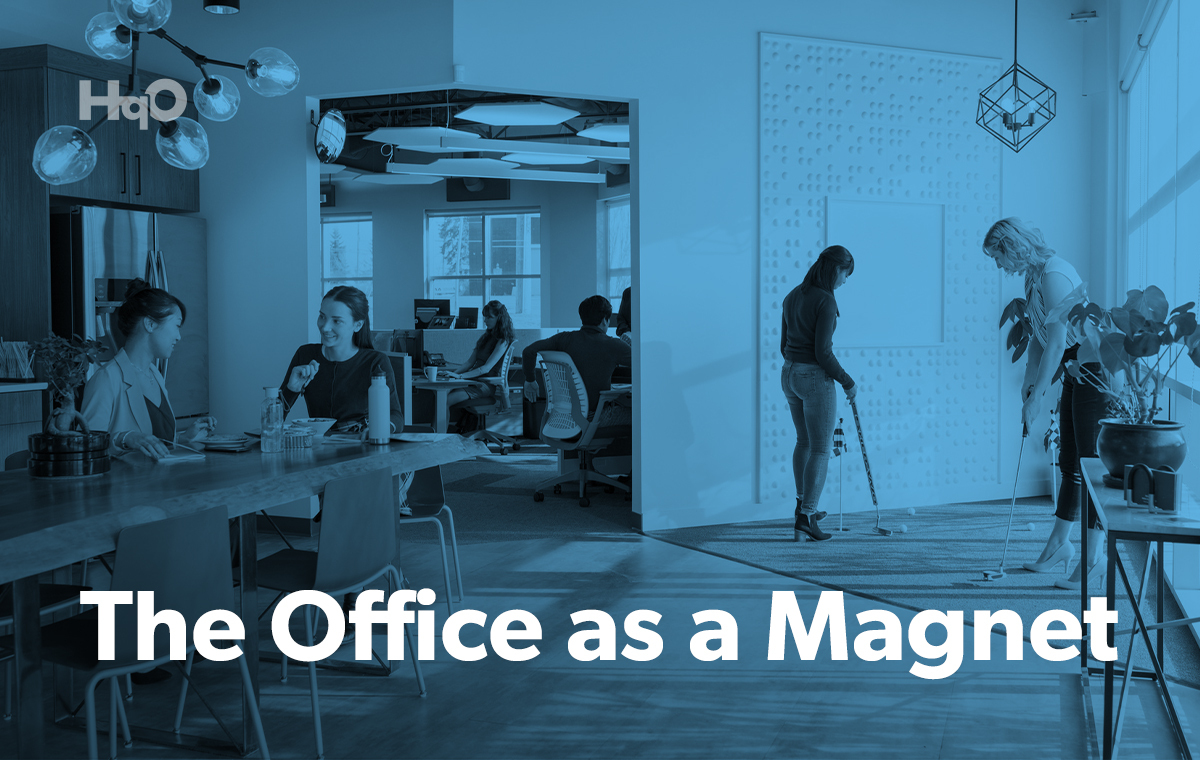In September 2021, leading commercial real estate firm CBRE released a study on the global trends shaping the future of the office. “Consolidation,” the report reads, “remains a focus for many multinationals. In EMEA, 40% of companies expect their portfolios to contract over the next three years, compared with a third who anticipate expansion. In the U.S., 44% of companies expect their portfolios to contract over the next three years, almost exclusively driven by large companies. However, the degree to which they expect to scale back their portfolio has moderated their sentiment throughout the pandemic. In general, occupiers continue to target high-quality properties in prime locations to satisfy employee expectations.”
Though some physical workspaces are downsizing, it provides organizations around the world the opportunity to redesign office spaces in a way that is more efficient, more attractive, and more usable in a post-COVID landscape.
“Because the office is no longer a mandate, it must become a magnet,” adds Fast Company. “A genuinely welcoming place where employees want to be, a place of social connection, and great tech where they feel a sense of belonging and can do their best work.”
Enhancing Your Strategies
To create such places, employers are doing more with less. Even those who are consolidating their physical workspaces and scaling back on size, are also focusing on transforming their offices into go-to destinations that are employee-centric, innovative, and productive. Those that haven’t yet must take action, lest they miss out on a competitive edge, both commercially and talent-wise.
We believe that the office will never disappear. The way it is used, however, is always evolving — especially in a post-COVID environment.
This means that there are benefits to both space consolidation and space reconfiguration. Here, “consolidation” refers to the reduction of the physical workplace, with “reconfiguration” being the redesign or repurposing of office space.
New Looks for the Office
While less employees in the office might drive some companies toward using less physical space, it does not downplay the need for a connected organization that is able to communicate, collaborate, and operate together. The office, in these cases, arguably becomes even more important, acting as a central hub that employees can use when and how they need to — and a foundation to hybrid work.
Companies should seek landlords that offer shared amenity spaces to easily accommodate days or periods when larger numbers of people are coming in, such as department or all-hands meetings. This means organizations can avoid leasing and maintaining these spaces, while still maintaining access to a common gathering area for employees.
Additionally, according to HqO’s Office Insights 2022 report, 86% of employers have already implemented flexible or hybrid working models since the beginning of the pandemic, with the remaining 14% planning to implement in the next two years. Similarly, 68% of employers have redesigned their workspaces to support employee needs, while 28% plan to implement redesigned spaces in the next two years.
Increased Productivity and Engagement
92% of survey respondents stated that maximizing productivity is important or very important to their workplace strategies. 90% of respondents also said that improving employee satisfaction is very important or important, with 88% stating that encouraging collaboration is very important or important.
The right workplace experience will deliver on all mentioned fronts, with the same report revealing that 76% of employers believe that workspaces that cater to both collaborative and flexible means of working are significant or very significant factors in attracting and retaining talent in the workforce..
“The more the workplace is connected in a thoughtful way to the organizational strategies, leadership models, operational frameworks, and potential outcomes of a company, the stronger the workplace will emerge,” Diane Hoskins, Co-CEO of global design and architecture firm Gensler, said in a February 2022 interview with McKinsey.
Decreased Operational Costs
Perhaps obvious, optimized space brings with it often beneficial financial results. “For corporates,” Deloitte’s report reads, “[space consolidation and reconfiguration] is an opportunity to reduce their operating costs and overall property costs, as well as business travel, energy consumption, and carbon footprint.”
Additionally, better functioning workplaces can produce a reduced carbon footprint, which in turn brings financial savings. This is because sustainability initiatives — or proof of organizational action towards improving environmental impact — act as both a driver of talent attraction and retention (especially among younger employees). This becomes an enormous cost-saver when compared to replacing employees who leave organizations for metaphorically greener pastures — which, according to Fast Company, can cost “anywhere from 50% to 200% of their salary.”
Long-Term Investments
While global organizations are increasingly reshaping their office portfolios, this does not mean that they are not investing in physical space; in fact, it’s just the opposite. Our Office Insights 2022 report reveals that 68% of employers believe that investing in dedicated employee and workplace experience tools is very significant or significant to attracting and retaining talent, with 72% having already or planning to redesign their workplaces in the next two years. These redesigns can be greatly improved if business leaders know exactly how much space their employees are using — and how they are using it.
Additionally, 56% see a significant need for employee behaviors to shift, in order to take advantage of the office. These behaviors, however, can only be shifted if the workplace is adjusted to meet evolving employee demands, meaning that flexibility, communication, and collaboration are key.
To learn more about how HqO can help optimize your office space, download our most recent report here.



